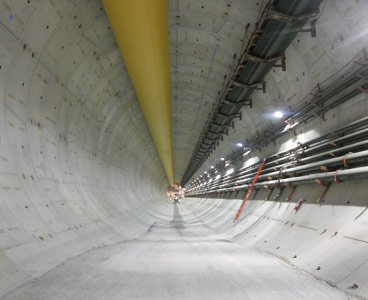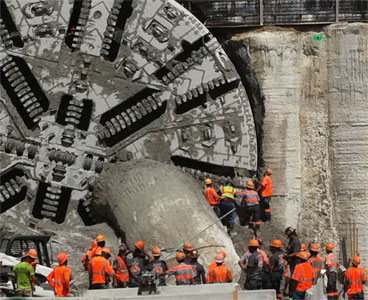First drive through for Miami Port link
Aug 2012
Shani Wallis, TunnelTalk
- Eight months after setting off in November 2011, the Herrenknecht hybrid EPBM has successfully holed through to complete the first 4,200ft (1,275m) drive of the twin tube Port of Miami highway tunnel in Florida. The breakthrough on Tuesday morning (31 July 2012) celebrated safe passage of the 42.3ft (12.95m) o.d. machine under the Government Cut waterway of the city's cruise-liner and cargo port through challenging geology of porous marine deposits and a potential hydrostatic head of some 120ft (36.5m) from tunnel invert at the deepest point to mean sea level.
- As a hybrid system, the machine operates in either the normal EPB mode, with material discharging from the screw conveyor onto a continuous conveyor muck hauling system, or in a 'water control process' (WCP) mode that bypasses the discharge gate and directs material from the screw conveyor through a mini-crusher and into a slurry pipeline circuit for pumping to a separation plant on the surface.
- "The TBM performed well through the drive," said Paul Trevisin, a TBM Superintendent with the construction contractor Bouygues Civil Works Florida. "We used the EPB mode for two thirds of the drive and the WCP mode for the middle section under the Cut where operating pressures were up to 3 bar."
- Unlike a conventional bentonite slurry system, the WCP mode, it was explained, operates as a water-based slurry and at the in-situ pressure in the ground. Rather than creating a pressure maintaining 'cake' to support safe draw down of the slurry in the excavation chamber for man-entry inspections and tool changes, the water-slurry system converts the conveyor hauling system to a closed pressure-controlling slurry transportation system. "The ground is too porous to maintain a pressurised bentonite type slurry operating system," said Trevisin. "The bentonite would be lost into the ground, which also contains large karst like features, and would fail to form the supporting slurry cake on the face. The WCP certainly made it easier to get under the Cut."
-

Twin tunnels run under the Government Cut channel on the left
- The machine was ordered initially as a straight EPB system. Subsequent geological investigations however, confirmed that additional technologies would be needed to manage conditions under the Cut. The geology is described as recent sedimentary carbonate rock with low consolidation and high variability, both horizontally and vertically, in terms of resistance, porosity and cohesion. Extra geological investigations also identified lower than anticipated fines content, making it not only too porous for a slurry operation, but also border-line favourability for efficient EBP operation in places.
- Having worked on retrofit of a hybrid pumping system to its EPB machines that worked on the challenging Arrowhead tunnels in California, Herrenknecht developed a similar system for the Miami machine and had it added during the machine's fabrication. An extra gantry and the pumps and pipework of the WCP mode followed delivery of the machine for incorporation at the assembly.
- Being aware of the nature of the material, the construction team introduced a system of ground treatment from the surface to treat zones along the alignment where five cross passages will be excavated to connect the twin highway tubes. One cross passage lies at the deepest point of the Cut and will include a sump while the others lie two each either side of the Cut and under Watson and Dodge Islands. The treatment process mixes a thick cement mortar with the ground to improve cohesion and reduce permeability. Treatment was also installed to facilitate launch and reception of the TBM under low cover and through reclaimed land on the islands.
- Treatment of these zones and at the cross passage locations progressed ahead of TBM launch and were extended laterally to cover the alignment of the two tunnel drives and create safe havens or plugs in which to programme TBM interventions for maintenance and tool changes.
- "At the start we were going in daily for brief inspections," explained Trevisin. "We then continued until the first cross-passage treatment plug at ring 130 or 221m into the drive, which presented a surprise. The abrasive ware of tools on the alignment curve to that point was more than anticipated. The decision was taken then to install a soil treated plug at every 130 rings and expand the treatment beneath the seabed of the Cut. This was in anticipation of higher than anticipated intervention sessions."
-

Programme on track for a mid-2014 opening to traffic
- All together there were four stops for extended maintenance and tool change intervention with a series of brief interventions for inspection in between. Each man entry to the excavation chamber was under a maximum of about 3 bar pressure.
- "It is a good looking tunnel," said John Critchfield, Site Engineer representing the client in the PPP procurement concession. "They've done a nice job. The segments are the best you'll find on any job and there are very few leak spots in the build that need follow-up."
- Work progressed 24hrs/day, 7 days/week with a 4hr maintenance shift in each 20hr excavation period. "Through the drive the tunnelling teams maintained their programme average of 4 x 1.7m rings/day or 47.6m/week," said Critchfield, "which has the breakthrough achieved pretty much on schedule and towards having the twin two-lane highway tunnels ready for going into service by the mid-2014 due date."
- Following breakthrough, work now begins to turn the machine on a turntable and set it up to drive the westbound tunnel back under the Cut to the main job site on Watson Island. Power, water supply and other TBM services will make the turn with the TBM for feed from the main working site, while the continuous mucking conveyor will move to follow the machine from Dodge Island. The backup trailers will be disconnected and linked again once the machine is into the new drive.
- Segments will be delivered also from the main work site on Watson Island through the completed eastbound tube and around into the return TBM drive with annual grout also pumped from the batching plant at the main working site through the eastbound tube to the second drive.
- In preparing for excavation of the second tube, the separation plant associated with the WCP system will also move to Dodge Island. Excavated material from both the EPB continuous conveyor and from the WCP separation plant will load on to trucks for transport off the island via its one traffic bridge for onward disposal. It is again planned for the machine to operate two-thirds in EPB mode and one-third, under the Cut, in WCP mode. The EPB mode provides slightly faster advance rates and different conditioning agent polymers were used to extend the technical limit of the conventional EPB mode. To improve the efficiency of the separation plant, French supplier MS will add a bank of filter presses for the second drive.
- Restart of the TBM on its return journey is scheduled for mid-October.
- Bouygues Civil Works Florida, as contractor for the project, is a division of the giant French parent group Bouygues, which has a 10% stake in the private equity portion of the project's PPP procurement with private equity group Meridiam holding the matching 90%. The construction contract is with the Miami Access Tunnel (MAT) group, which secured the 35-year PPP project in 2009, and Transfield Services is contracted to operate and maintain the tunnel through the concession period.
- Client for the project comprises three public agencies: the Florida State Department of Transportation (FDOT), Miami-Dade County and the City of Miami. Once completed, FDOT will make annual operating and maintenance payments to MAT on availability of the infrastructure.
-
Groundbreaking gets Port of Miami Tunnel underway - TunnelTalk, July 2010
Clawing success from the extreme at Arrowhead - TunnelTalk, December 2007
|
|
|
|
|
Add your comment
- Thank you for taking the time to share your thoughts and comments. You share in the wider tunnelling community, so please keep your comments smart and civil. Don't attack other readers personally, and keep your language professional.


